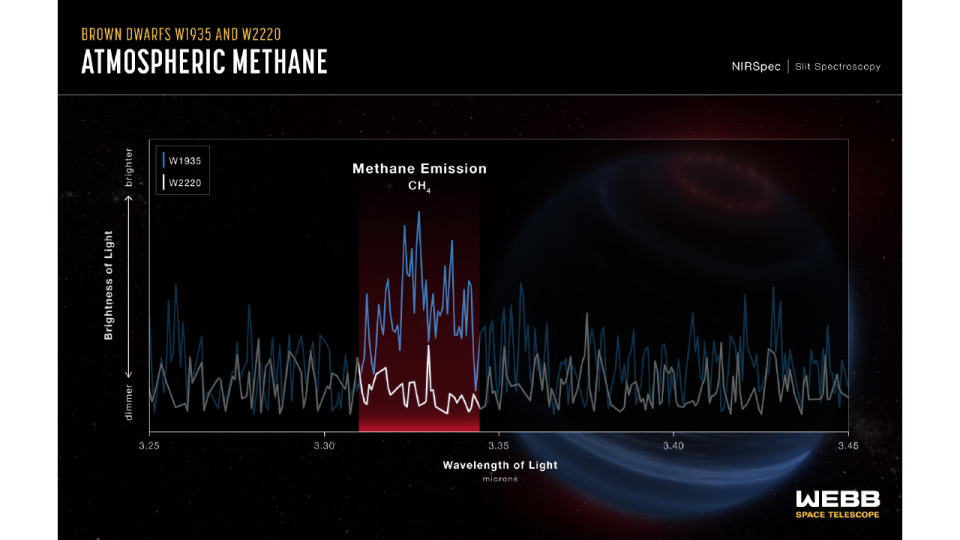Using NASA’s James Webb Space Telescope (JWST), astronomers spotted a “failed star” or brown dwarf that shows signs of having an aurora.
Auroras are more commonly known as the northern and southern lights, which result from charged particles from the sun hitting molecules in the Earth’s atmosphere. They are usually only seen at high latitudes, because our planet’s magnetosphere deflects these particles towards the poles.
Auroras can be seen around other planets in our solar system, such as Jupiter and Saturn, and even over active moons such as Jupiter’s Io and Saturn’s Enceladus. All these light displays are probably caused by the bombardment of charged solar particles.
So the newly discovered apparent aurora around the brown dwarf, named W1935 and located more than 40 light years from Earth, is mysterious; there are no stars close to it that could be providing the charged particles to burn it.
Related: A ‘failed star’ is the coolest source of radio waves ever discovered
Brown dwarfs are larger than gas giant planets and smaller than stars but form like stars, from a collapsing cloud of gas and dust. This means that most brown dwarfs are often isolated from stars, just like W1935.
They get their somewhat unfair nickname, “failed stars,” because they don’t have enough mass to fuel the nuclear fusion of hydrogen into helium in their cores, the process that powers stars, at least in their main sequence lifetimes.

The potential aurora over W1935 was indicated by infrared emissions from methane, observed by JWST. When methane emissions like these are seen over Jupiter and Saturn, they are the result of atmospheric heating as charged particles collide with magnetic field lines and collide with atmospheric particles, also creating aurorae. So the study team thinks the same applies to this isolated brown dwarf.
With the absence of an external solar wind to cause the brown dwarf’s likely aurora, the team believes that some internal processes may be occurring within the brown dwarf supplying energy to its atmosphere. Alternatively, W1935 may have been hit by interstellar plasma, or the brown dwarf may not be completely isolated and may be receiving an influx of particles from a nearby active moon.
The James Webb Space Telescope plays spot the difference with 2 brown dwarfs
The team of scientists, led by American Museum of Natural History astronomer Jackie Faherty, made the discovery while investigating 12 brown dwarfs with JWST.
Among these were W1935 and W2220, two very similar brown dwarfs that the $10 billion telescope found were close clones of each other, sharing similar temperatures and luminosities as well as compositions of water, ammonia, carbon monoxide and carbon dioxide. was almost identical.
However, W1935 differed from its close twin in that it contained methane that emitted infrared light. On W2220, the same chemical compound was absorbing light.
“We expected to see methane, because methane is all over these brown dwarfs. But instead of absorbing the light, we saw just the opposite: The methane was glowing,” Faherty said in a statement. “My first thought was, what the heck? Why is methane emission coming out of the object?”
Modeling the brown dwarf’s atmosphere to determine the cause of the methane emission, the team found the atmosphere of W2220 cooling with height, but the atmosphere of W1935 appears to be experiencing a temperature inversion that sees its atmosphere warming up at higher altitudes.
“This temperature inversion is very interesting,” said research modeler Ben Burningham from the University of Hertfordshire in England, in the same statement. “We’ve seen this kind of phenomenon in a planet with a nearby star that can heat the stratosphere, but to see it in an object with no obvious external heat source, it’s wild.”
That led the team to go to Jupiter and Saturn for an explanation, and found that there is a visible temperature inversion in the atmospheres of these gas giants in the solar system as well. The leading theory for this is heating by the same process that is creating the aurora.
RELATED STORIES:
— A strange brown dwarf ‘The Accident’ suggests possible cosmic anomalies
— Brown dwarfs: Coolest stars or hottest planets?
— amateur astronomer sees 34 ‘failed’ stars paired in brown dwarf project
Aurorae have previously been used to explain the unusual properties of brown matter, such as radio emissions from hotter samples of these failed stars. However, the JWST W1935 observations represent the first time methane emission from a brown dwarf has been observed, indicating an aurora.
“With W1935, we now have an amazing extension of the solar system phenomenon without any stellar radiation to help explain it,” Faherty concluded. “With the JWST, we can really ‘open the hood’ on the chemistry and unpack how similar or different the auroral process can be beyond our solar system.”
Faherty presented the team’s work this week at the 243rd meeting of the American Astronomical Society in New Orleans.